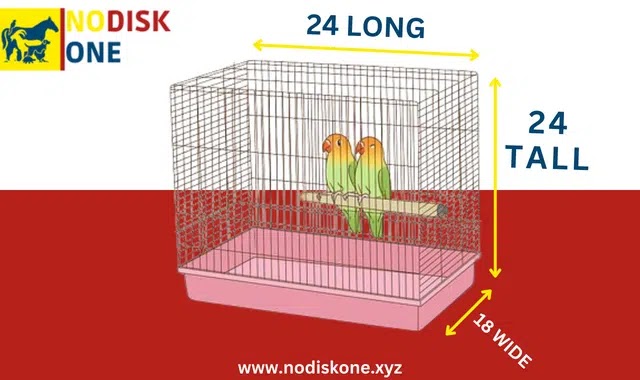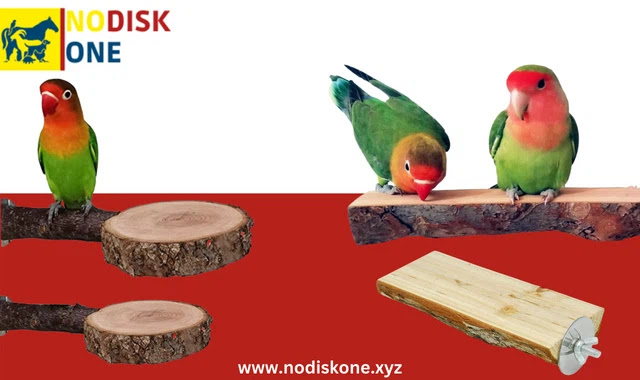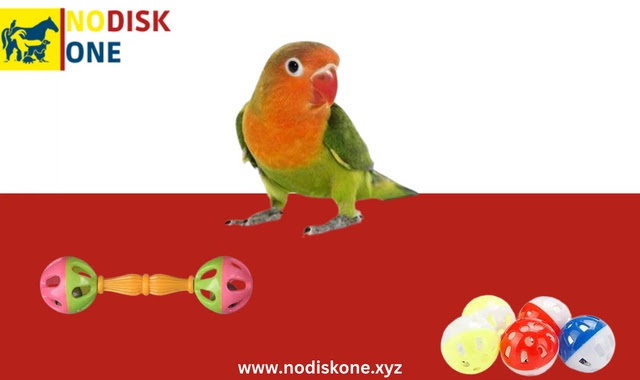Providing your pet with enough living space is one of the fundamentals of bird ownership. With all the different sizes, colors, and designs of bird cages today, it's easy to get overwhelmed when buying a home for your pet. Cages are the most overlooked factor when adopting pet birds deliberately. Almost no one thinks about the cages as they work out a meal plan, the workouts and the vet visits.
 |
| Lovebirds Cage: How To Choose The Right Cage For Lovebirds? |
Lovebirds are considered medium-sized birds, so you won't need anything too big! Although bigger is always better. If you're limited on space, you can get away with a smaller cage. Try to remember; your bird will be spending much of its time in its home, so try to make it as comfortable as possible with some of the tips I'm going to mention in this article!
This is an informative article. Nodisk One is not permitted to make a diagnosis or recommend any form of veterinary care. If your pet is in pain or ill, we recommend that you take him to the vet.
Before You Start
Keeping lovebirds with other parrot species is not advised as they can be quite territorial and defensive towards their home and mate and will likely end up fighting with another species. They should ideally be kept in related pairs, but can be kept alone if given adequate attention. In this case, they will form strong bonds with their human owners and will need a lot of interaction and attention.
Lovebirds are very active animals and as such need plenty of room to play, with plenty of perches, supports and lots of toys. Also, since they are ideally kept in pairs, they will need even more space than most other parrots.
Best Cage Size For A Lovebird
When choosing the size of a cage, consider the number of lovebirds you are going to have. A lovebird cage should generally measure at least 18 inches wide by 18 inches long by 18 inches high (bigger is better!).
If you're thinking of a pair of lovebirds, their cage should be no less than 24″ long, 18″ wide by 24″ long. This will ensure your lovebird has plenty of room to flap, climb, and just be birds.
- The Best Cage Size For A Lovebird: no less than 18″ wide by 18″ long by 18″ high.
 |
| Cage Size For A Lovebird |
- The Best Cage Size For Two Lovebirds: 24″ long, 18″ wide by 24″ long.
 |
| Cage Size For Two Lovebirds |
NOTE
>- Try to find a cage with a lock. This will save you from any unwanted breakouts!
- These are the minimum measurements for lovebirds. Always get a larger cage if you can. This will lead to a happier lovebird!
What Does Every Lovebird Cage Need?
All bird cages need a wide variety of things to complete. Usually a setup will include perches, climbing gear, 3 bowls, and toys. Let's explore each of them in more detail:
Perches For Your Lovebird Cage
Perches are essential for a cage setup; not only will they help your feathered friend get around, but they will also act as a workout for your birds little feet to mimic their natural state in the wild! Perches are important for any setup!
It is important to get different types of perches for your bird to enjoy. The main types of perches are rope, wooden, and platform perches, and each is vital to your birds' lifestyle! When buying wooden perches, remember to buy different shapes and sizes to mimic different branches in nature! Your bird will appreciate it!
 |
| Bird Platform Perch |
Platform perches have a completely different but essential advantage for your cage! Everyone, including your lovebird, needs a break. Platform perches allow your lovebird to rest on the other perches and allow them to rest their little feet.
Climbing Equipment
 |
| Climbing Equipment |
Climbing gear is important for keeping your bird stimulated while moving around its home. You can get many types of climbing gear, from ropes to small ladders. However, they should be part of every setup in some form!
Toys For Lovebirds
The mental stimulation provided by toys can keep your bird happy. No one likes to sit around doing nothing all day, and the same goes for your bird! There are many great toys to choose from, made from materials proven to give your bird the most joy.
 |
| Toys For Lovebirds |
Try to find toys made of paper, wood or palm leaves. These materials facilitate tearing and are not as dangerous if swallowed by mistake. If you can, stay as far away from plastics as possible. If ingested may cause problems.
Foraging Toys For Lovebirds
 |
| Foraging Toys For Lovebirds |
These toys are ideal for mimicking what your parrot would naturally do in the wild by spending time separating objects to reach the treat in the middle. Foraging toys can keep them busy for a while while stimulating their basic instincts.
Food And Water Bowls: Which Is Better, Plastic Or Stainless Steel?
All bird cages need a minimum of 2 bowls but ideally 3 if you can find space! Each bowl has a function. The first bowl will be for water, the second bowl for dry foods (granules) and the third bowl for fruits and vegetables. It's a good idea to keep their food separate for hygienic reasons!
 |
| Food And Water Bowls |
There's a crucial reason the subtitle says "Plastic or Stainless Steel." Ideally, you want to get rid of the standard plastic bowls and replace them with stainless steel bowls. Stainless steel bowls are easier to clean and don't accumulate as much bad bacteria
You don't want them to get sick from what they eat!
Cages Suitable For Lovebirds
Not all bird cages are suitable for lovebirds, and we recommend purchasing a cage specifically designed for lovebirds or other small parrots such as parakeets. The spacing of the cage bars is extremely important and should be tight enough that your lovebirds cannot squeeze in and out or get stuck. Wire cages are best because your lovebird cannot chew through the bars and the spacing should be no more than ½ inch.
The bars must also be perfectly parallel and not converge at any point. Your lovebirds can slide down the bars and get stuck at the convergence point, which can hurt them. Also, make sure the cage you buy is free of any potentially toxic materials, as these birds love to chew, and make sure there are no sharp edges that could hurt them.
Before buying, check that the cage doors have secure locks - lovebirds are intelligent animals that can easily learn to open unlocked doors.
Door Mechanisms And Locking Systems
Lovebirds are smart. I found out when Apache started opening his cage doors. Looking at door mechanisms and locks is therefore important. Try to avoid guillotine style door mechanisms. These doors easily slide up and down. If your lovebird finds how to open them, they may get stuck halfway through.
A drawbridge style door can be useful as it provides a platform for your bird to stand on when it leaves the cage. A hinged door is also good. Your lovebird should not be able to unlock his doors. Make sure there is a suitable locking mechanism that your lovebird cannot reach.
Accessibility For Cleaning And Feeding
The cage you buy should be easily accessible for cleaning and feeding, with separate doors for each. Typically, the feed door will be small and just large enough to feed your birds, and the cage should have a larger door for cleaning and adding and removing toys or baths.
We also highly recommend purchasing a cage with a removable bottom tray. This will greatly simplify cleaning your bird's cage as you can simply slide out the tray to clean it rather than having to remove everything from inside the cage. You can line the cage with newspaper for even easier cleaning.
Where A Lovebird Cage Should Be Placed?
Cage positioning may be more important than you think. Before purchasing your Lovebird cage, determine where it will be located in your home. This will help you narrow down the size you can handle, and then you can buy the right size cage accordingly.
Your lovebird's cage should be out of direct sunlight and not too close to windows, but still have plenty of natural light and plenty of air circulation. Your lovebird is a social creature that likes to be close to its owners, so try to keep them where they will be part of the daily activity of your home. Finally, their cage should be located high up and away from other animals in your home.
Ideally, you want their cage to be placed in an open space away from kitchen smoke and the scents of air fresheners. Many kitchen pots and pans are made from Teflon, which is generally not a problem for humans. However, if overheated and burned, Teflon emits toxic gases that are harmful to birds, and in some severe cases, without ventilation, can cause serious respiratory problems.
We also recommend purchasing a cage cover to help your birds feel safe at night. This cover must be specially designed for bird cages. Don't use towels or bedding, as your bird's claws can get caught in the fibers.
Transport Cages For Lovebirds
Sometimes lovebirds need to be moved from place to place, or you need to clean their cage and don't want them out. Having a secondary carrier can be handy. Roughly the ideal size for a carrier should be 50cm long, 30cm high and 42cm wide with two bowls for food and water if needed and a single perch for them to roost in. rest.
 |
| Transport Cages For Birds |
The best way to coax your lovebird into a travel crate is to rest it on your hand and while stroking its head, move its tail first into the crate. This way they won't feel trapped in an unfamiliar cage.
Fact About The Lovebirds
- Lovebirds are tiny parrot family members. They are smart and lively little birds that come in a variety of pretty colors.
- Lovebirds, especially males, can become very attached to their owners, but if kept in pairs they will bond with their cage mate for life.
- The lovebirds can live up to 15 years, so it's quite a commitment!
- Lovebirds are very territorial and will defend their home and mate. For this reason, you cannot keep lovebirds with other birds of a different species, including other parrots.
- Also, it's not a good idea to keep more than two birds in the same cage because they might fight.
Conclusion
Housing a lovebird isn't difficult, and it doesn't take much to give your lovebird an environment where they can thrive. Try to get the biggest cage you can manage, make sure the bars are tightly spaced, and get a horizontal one rather than a vertical one to give them enough room to fly. With all of these requirements covered, your lovebird should be able to live a long and happy life!
Only credible sources, such as peer-reviewed studies, are used by Nodisk One to substantiate the information in our articles.



Comments